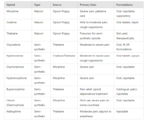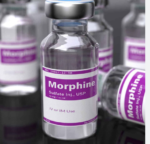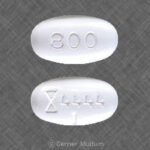Drug Class: Opioid Analgesics

WHAT IS MORPHINE AND HOW DOES IT WORK?
Morphine is used to treat severe pain. Morphine belongs to a class of drugs known as opioid (narcotic) analgesics. It works in the brain to change how your body feels and responds to pain.
Morphine is available under the following different brand names: MS Contin, Astramorph, Depodur, Duramorph, Infumorph, Kadian, MorphaBond, and Arymo ER.
DOSAGES OF MORPHINE
Dosage Forms and Strengths
Tablet, extended-release (MS Contin): Schedule II
- 15mg, 30mg, 60mg, 100mg, 200mg
Tablet, extended release (abuse-deterrent): Schedule II
- 15 mg, 30 mg, 60 mg (Arymo ER)
- 15 mg, 30 mg, 60 mg, 100 mg (MorphaBond)
Capsule, morphine sulfate extended-release: Schedule II
- 10 mg, 20 mg, 30 mg, 45 mg, 50 mg, 60 mg
- 75 mg, 80 mg, 90 mg, 100 mg, 120 mg
Capsule, extended-release (Kadian): Schedule II
- 10 mg, 20 mg, 30 mg, 40 mg, 50 mg, 60 mg
- 70 mg, 80 mg, 100 mg, 130 mg, 150 mg, 200 mg
Injectable suspension, extended-release, liposomal (DepoDur): Schedule II
- 10 mg/mL
Injectable solution (Duramorph): Schedule II
- 0.5 mg/mL
- 1 mg/mL
Injectable solution, high potency (Infumorph): Schedule II
- 10 mg/mL (200 mg/20mL ampule)
- 25 mg/mL (500 mg/20mL ampule)
Morphine sulfate, injectable solution: Schedule II (adult and pediatric)
- 0.5 mg/mL, 1 mg/mL, 2 mg/mL, 4 mg/mL, 5 mg/mL
- 8 mg/mL, 10 mg/mL, 15 mg/mL, 25 mg/mL, 50 mg/mL
Tablet, morphine sulfate immediate release: Schedule II (adult and pediatric)
- 15 mg, 30 mg
Morphine sulfate, suppository: Schedule II
- 5 mg, 10 mg, 20 mg, 30 mg
Morphine sulfate, oral solution: Schedule II
- 10 mg/5mL; 20 mg/5mL
Morphine sulfate, intramuscular device
- 10 mg/0.7mL
Dosage Considerations – Should be Given as Follows:
Addiction, abuse, and misuse:
- Risk of opioid addiction, abuse, and misuse, which can lead to overdose and death
- Assess each patient’s risk prior to prescribing and monitor all patients regularly for the development of these behaviors or conditions
Acute Pain
Immediate-release tablet
- Opioid-naïve patients: 15-30 mg orally every 4 hours as needed
Oral solution
- Opioid-naïve patients: 10-20 mg orally every 4 hours as needed
Suppository
- 10-20 mg PR every 4 hours
Parenteral solution
- Subcutaneously/intramuscularly (SC/IM) (opioid-naïve patients): 5-10 mg every 4 hours as needed; dose range, 5-20 mg
- Intravenously (IV) (opioid-naïve patients): 2.5-5 mg every 3-4 hours as needed, infused over 4-5 minutes; dose range, 4-10 mg
Preservative-free parenteral solution
- Epidural injection
- Single dose: 5-10 mg once daily in lumbar region
- Continuous infusion: 2-4 mg IV infused over 24 hours
- Intrathecal (IT)
- Single dose (opioid naive patients): 0.1-0.3 mg single dose, plus available infusion of naloxone; dosage range per manufacturer, is 0.2-1 mg/day; because repeated IT injections are not recommended, alternative route should be used if pain recurs within 24 hours
- Continuous infusion (opioid naive patients): 0 .2-1 mg on lumbar region over 24 hours
- Continuous infusion (opioid tolerant): 1-10 mg over 24 hours microinfusion on lumbar region; not to exceed 20 mg over 24 hours
Extended-release liposomal injection
- DepoDur treatment of pain after major surgical procedures
- After cesarean section: 10 mg as single lumbar epidural injection after umbilical cord is clamped
- Major orthopedic surgery of lower extremity: 10-15 mg as single lumbar epidural injection before procedure
- Lower abdominal or pelvic surgery: 10-15 mg as single lumbar epidural injection before procedure; may benefit from 20 mg dose
Dosing considerations
- Injection formulation not for intravenous (IV) administration unless opioid antagonist immediately available
- Usual dosage of IV morphine in adults, regardless of indication, is 2-10 mg/70 kg body weight
- Consider lowest end of dosing range and monitor for side effects in elderly patients and those with renal or hepatic impairment
- Opioid-tolerant patients may require higher initial doses; patients are considered opioid-tolerant if they take at least 60 mg/day orally of morphine, 30 mg/day orally of oxycodone, 12 mg/day orally of hydromorphone, or equianalgesic dose of another opioid for more than 1 week
- Oral solution: 100 mg/5 mL concentration is appropriate only for opioid-tolerant patients
- Parenteral solution: Intramuscular (IM) injection is painful and has variable onset of analgesia because of delayed onset of action and erratic absorption; repeated subcutaneous (SC) administration may cause local tissue damage, as well as induration, irritation, and pain at injection site
- Preservative-free parenteral solution: American Pain Society describes “ceiling” for analgesic effect with dosages greater than 0.3 mg/day and increase in adverse effects (e.g., respiratory depression); extreme caution is warranted with epidural or intrathecal (IT) administration in aged or debilitated patients, and lower dosages are usually adequate
- Extended-release liposomal injectable suspension: To be administered only in a single dose via lumbar epidural route; not recommended for administration into thoracic or higher epidural spaces; not to be administered IT, IV, or IM
Chronic Severe Pain
Extended-release (ER)/long-acting (LA) formulations are indicated for management of severe pain requiring daily, around-the-clock, long-term opioid treatment for which alternative options are inadequate
Immediate-release (IR): May also be used for management of chronic pain but require more frequent dosing; may also be used in combination with ER/LA products for breakthrough pain
Extended-release tablet (MS Contin)
- Opioid-naïve patients (as first opioid dose): Initiate with 15 mg orally every 8-12 hours; use of higher starting doses in patients who are not opioid tolerant may cause fatal respiratory depression
- Opioid-tolerant patients: Dose depends on daily dose of previous opioid analgesic (individualization required for conversion)
- MS Contin dose equivalent to one-half of patient’s calculated 24-hr orally morphine requirement every 12 hours; alternatively, dose equivalent to one-third of patient’s calculated 24-hr orally morphine requirement every 8 hours
- Tablet must be swallowed whole and not broken, chewed, dissolved, or crushed; sudden release of morphine content increases risk of respiratory depression and death
Extended-release capsule (Kadian)
- Opioid-naive patients: Not indicated for use as initial opioid analgesic; initiate with immediate-release (IR) formulation, then convert to Kadian
- Nonopioid-tolerant patients: 30 mg orally once/day
- Opioid-tolerant patients: Dose depends on daily dose of previous opioid analgesic (individualization required for conversion)
- Kadian dose equivalent to one half of patient’s 24-hr orally morphine requirement every 12 hours; alternatively, dose equivalent to patient’s 24-hr orally morphine requirement once daily
- Capsule must be swallowed whole, or contents must be sprinkled on applesauce and immediately swallowed; must not be chewed, crushed, or dissolved; sudden release of morphine content increases risk of respiratory depression and death
Extended-release tablet, abuse deterrent (MorphaBond)
- Opioid-naïve patients (as first opioid dose): 15 mg orally every 12 hours
- Opioid-tolerant patients: Dose depends on daily dose of previous opioid analgesic (individualization required for conversion)
- MorphaBond dose equivalent to one-half of patient’s calculated 24-hr orally morphine requirement administered every 12 hours
- Tablet must be swallowed whole and not broken, chewed, dissolved, or crushed; sudden release of morphine content increases risk of respiratory depression and death
Extended-release tablet, abuse-deterrent (Arymo ER)
- Initial dosing
- Opioid naïve patients and opioid non-tolerant patients: 15 mg orally every 8-12 hours
- Conversion to Arymo ER
- Morphine recipients: Administer one-half of 24-hr morphine requirement as Arymo ER orally every 12 hours, or one-third of 24-hr morphine requirement as Arymo ER orally every 8 hours
- Patients receiving other opioids: Discontinue all around-the-clock opioid drugs, then initiate Arymo ER 15mg orally every 8 hours Arymo ER dose when converted from other opioids or parenteral morphine: Calculate 24-hr orally
morphine equivalent requirement and administer one-half of that daily equivalent as Arymo ER every 12 hours; alternatively, may give one-third of patient’s calculated 24-hour orally morphine requirement every 8 hours
- Methadone to morphine sulfate ER conversion: Methadone has long-half-life and may accumulate in plasma; conversion dose may vary widely; judicious dosing and close monitoring is warranted
High-potency injectable solution (Infumorph)
- Treatment of intractable chronic pain
- Starting dose for epidural or intrathecal (IT) administration must be individualized on basis of in-hospital evaluation of response to serial single-dose bolus injections using lower concentration of preservative-free morphine solution, with close observation of analgesic efficacy and adverse effects before surgery involving continuous microinfusion device
- IT (opioid-naïve patients): 0.2-1 mg over 24 hours
- IT (opioid-tolerant patients): 1-10 mg over 24 hours; caution warranted with dosages greater than 20 mg/24 hours
- Epidural (opioid-naïve patients): 3.5-7.5 mg over 24 hours
- Epidural (opioid-tolerant patients) 4.5-10 mg over 24 hours
Opioid-tolerant definition
- Patients who are opioid tolerant are those receiving, for 1 week or longer, at least 60 mg/day orally morphine, 25 mcg/hour transdermal fentanyl, 30 mg/day orally oxycodone, 8 mg/day orally hydromorphone, 25 mg/day orally oxymorphone, or an equianalgesic dose of another opioid
Limitations of use
- Because of the risks of addiction, abuse, and misuse with opioids, even at recommended doses, and because of the greater risks of overdose and death with extended-release opioid formulations, reserve for patients whom alternative treatment options (e.g., non-opioid analgesics or immediate-release opioids) are ineffective, not tolerated, or would be otherwise inadequate to provide sufficient management of pain
- Not indicated for acute pain or as a as needed analgesic
Pediatric
Analgesia/Cyanotic Tetralogy of Fallot
- Neonates (less than 30 days): 0.3-1.2 mg/kg/day intramuscular/subcutaneous (IM/SC) divided every 4 hours; 0.005-0.03 mg/kg/hour slow intravenous (IV)
- Infants and children (oral solution): 0.2-0.5 mg/kg orally ever 4-6 hours as needed
- Infants and children (IM/SC): 0.05-0.2 mg/kg every 2-4 hours as needed; not to exceed 15 mg/dose
Pain
- Continuous infusion: 0.025-2.6 mg/kg/hour intravenously (IV); average, 0.06 mg/kg/hour
- Neonates (less than 30 days): 0.01-0.02 mg/kg/hour by IV infusion
- Postoperative pain: 0.01-0.04 mg/kg/hour by IV infusion
- Sickle-cell disease, cancer: 0.04-0.07 mg/kg/hour by IV infusion
Pain Medications, Pain Relief, and Pain Management






